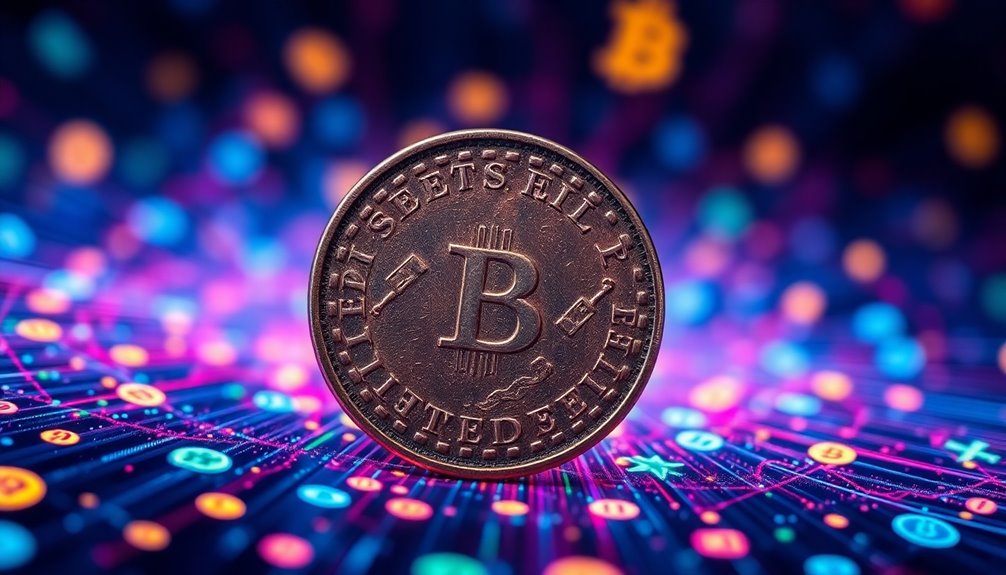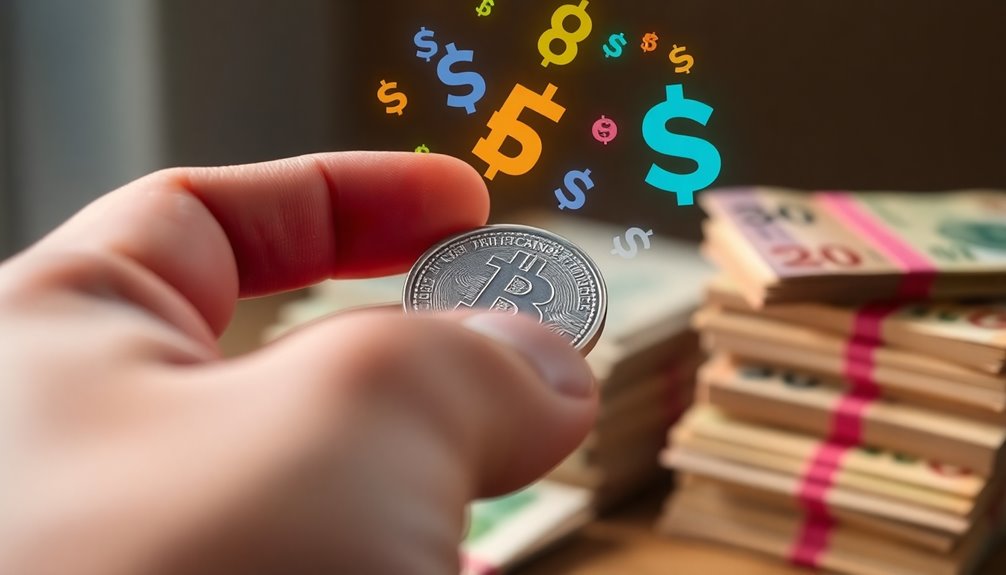Fiat currency in crypto refers to government-issued money recognized as legal tender, like the U. S. dollar. It contrasts sharply with cryptocurrencies, which can be volatile. Governments control the supply of fiat through central banks to manage economic stability and inflation, making it a stable medium for transactions. While fiat currencies are essential for maintaining trust and legitimacy in financial systems, cryptocurrencies can be riskier investments due to their price fluctuations. Understanding how these currencies interact and the emergence of central bank digital currencies can provide deeper insights into the future of finance. As the financial landscape evolves, the concept of digital currencies is gaining traction, especially with the rise of central bank digital currencies (CBDCs), which aim to combine the stability of fiat with the benefits of technology. This shift prompts a reevaluation of the traditional money market definition and overview, as both fiat currencies and cryptocurrencies influence liquidity and investment strategies. As more countries explore the integration of digital assets, the implications for global trade and financial regulation continue to unfold, highlighting the need for adaptability in modern economic systems.
Key Takeaways
- Fiat currency refers to government-issued money recognized as legal tender, unlike cryptocurrencies which are decentralized and not government-backed.
- In the context of crypto, fiat currency is often used to buy cryptocurrencies on exchanges, facilitating their entry into the market.
- Stablecoins are a type of cryptocurrency pegged to fiat currencies, aiming to provide stability and reduce volatility in the crypto market.
- The value of fiat currency is based on public trust and government backing, contrasting with the speculative nature of many cryptocurrencies.
- Fiat currencies can also be digitized for transactions, while cryptocurrencies exist solely in digital form, highlighting their different roles in the economy.
Fiat's Government-Backed Legitimacy

While you might be familiar with the concept of money, understanding fiat currency's government-backed legitimacy is essential.
Fiat currency, like the U.S. dollar and the Euro, is recognized as legal tender for all debts and transactions. Central banks control its supply, using monetary policy to manage inflation and guarantee economic stability.
The value of fiat hinges on government decree and the public's trust in the government's ability to meet its financial obligations.
Unlike cryptocurrencies, which lack regulation, fiat currencies operate within strict regulatory frameworks designed to prevent fraud.
This government-backed legitimacy helps maintain a relatively stable value, making fiat a reliable medium of exchange amid the high volatility often associated with cryptocurrencies.
Historical Context of Fiat Currency

As societies evolved, the need for a flexible and efficient medium of exchange became clear, leading to the rise of fiat currency. The term "fiat" comes from the Latin for "let it be done," signifying its nature as a government decree rather than being backed by commodities like the gold standard.
In the 20th century, fiat currency gained prominence, allowing for greater flexibility in monetary policy. The U.S. dollar, established as fiat in 1971, became the world's primary reserve currency, shaping global trade.
However, historical hyperinflation instances, such as in Zimbabwe, show the risks of excessive printing and loss of value. Ultimately, fiat's worth relies on trust in government, economic stability, and factors like inflation rather than intrinsic value.
Currency Issued by Governments

Governments issue fiat currency, which serves as the backbone of modern economies. This government-issued money, like the US Dollar and Euro, is recognized as legal tender for transactions.
Unlike cryptocurrencies, fiat currencies are regulated by central banks, ensuring economic stability. The value of fiat currency comes from the trust and confidence people place in the government and its ability to manage the economy, instead of being backed by physical commodities.
Central banks utilize monetary policy tools, such as interest rates, to adjust the currency supply, manage inflation, and stimulate growth.
Fiat currencies exist in both physical forms, like coins, and digital representations, such as bank deposits, facilitating a range of transactions in today's economy.
Pros and Cons of Fiat

Fiat currency offers several advantages that make it a cornerstone of modern economies. It's widely accepted as money, ensuring seamless transactions in daily life.
Backed by a central authority, fiat currencies provide a stable medium of exchange, allowing governments to implement monetary policies that stabilize the financial system.
However, the value of fiat can be eroded by inflation, with historical examples showing significant devaluation over time. Additionally, government manipulation can lead to a loss of trust, especially during economic crises.
Despite these downsides, the established regulatory environment surrounding fiat currencies enhances consumer protections, reducing risks associated with fraud and market volatility. Furthermore, understanding interest rates is crucial as they directly impact the value of fiat currency and its purchasing power over time.
Fiat vs. Crypto Volatility

While fiat currencies provide stability in everyday transactions, the landscape shifts dramatically when comparing them to cryptocurrencies. Fiat currencies like the US Dollar experience gradual devaluation due to inflation and are influenced by government policies.
In contrast, cryptocurrencies are notorious for their volatility, with price fluctuations driven by market speculation and investor sentiment. For instance, Bitcoin skyrocketed from around $100 in 2013 to over $40,000 in 2021, highlighting its unpredictable nature.
Although stablecoins attempt to mitigate this volatility by pegging their value to fiat currencies, they still face challenges like regulatory scrutiny.
Ultimately, the rapid gains or losses in cryptocurrency investment present significant risks compared to the more stable trajectory of fiat currencies.
Market Manipulation Concerns

How can investors navigate the murky waters of cryptocurrency markets where manipulation runs rampant? Market manipulation, such as pump-and-dump schemes, can leave unsuspecting investors reeling from significant losses.
Many cryptocurrencies, including Bitcoin, face a lack of regulation, making them prime targets for manipulators. Studies suggest up to 95% of Bitcoin trading volume might be fake, further complicating market prices.
Whales can influence these prices with large trades, creating volatility that misleads investors. Regulatory bodies like the SEC are concerned, pushing for stricter rules to protect you.
Additionally, the rise of stablecoins raises questions about transparency and reserve backing, as seen in the collapse of TerraUSD. Staying informed is vital to safeguarding your investments.
Emergence of Central Bank Digital Currencies

As the financial landscape evolves, Central Bank Digital Currencies (CBDCs) have emerged as a significant development in the domain of digital finance. These digital currencies, issued by central banks, aim to combine the stability of fiat money's value with the efficiency of digital transactions.
Over 100 countries, with China leading through its digital yuan pilot, are exploring CBDCs. They seek to enhance payment efficiency, reduce transaction costs, and foster financial inclusion, particularly in underserved regions.
Unlike cryptocurrencies that rely on decentralized networks, CBDCs are centralized and governed by monetary policy. Their emergence could reshape the global financial landscape, impacting cross-border payments and potentially challenging the dominance of traditional fiat currencies and private cryptocurrencies.
Diversify Currency Holdings Wisely

To navigate the complexities of today's financial markets, it's crucial to diversify your currency holdings wisely. By blending fiat currencies like the US Dollar or Euro with digital currencies, you can mitigate risks associated with market volatility.
Fiat offers stability, while cryptocurrencies can yield significant returns. Including stablecoins in your investments can provide a buffer against crypto volatility, as they're pegged to fiat currencies.
This strategy enhances liquidity, allowing easier access to your funds during downturns. Remember, the correlation between fiat values and cryptocurrency valuation can be influenced by regulatory changes and monetary policies.
Regularly reviewing and adjusting your holdings based on these factors will optimize your investment strategy and maintain a balanced portfolio.
Frequently Asked Questions
What Is Fiat on Crypto?
When you use fiat on crypto platforms, you're converting traditional currencies like USD or EUR into cryptocurrencies. This process makes it easier for you to buy, sell, or trade digital assets.
Many exchanges provide fiat on-ramps, allowing you to deposit money directly and convert it. By integrating fiat currencies, these platforms enhance usability and acceptance, ensuring that you can engage with cryptocurrencies effortlessly and take part in the growing digital economy.
What Is an Example of a Fiat Currency?
Imagine a river flowing through a bustling city, representing the flow of money that fuels everyday life.
An example of a fiat currency is the US Dollar (USD), which acts as the lifeblood of international trade and commerce. You rely on its value, shaped by trust in the government and economic demand.
Other currencies like the Euro or Japanese Yen share this role, each symbolizing stability in an ever-changing financial landscape.
Is Bitcoin a Fiat Money Too?
No, Bitcoin isn't fiat money.
While fiat currencies are backed by governments and can be printed at will, Bitcoin operates independently and has a limited supply of 21 million coins.
Its value comes from market demand rather than government decree, making it more volatile.
Unlike fiat, Bitcoin transactions are irreversible, and it serves as a decentralized medium of exchange and potential store of value, contrasting sharply with traditional fiat currencies.
Is USD a Fiat Currency?
You've probably heard the saying, "Money doesn't grow on trees," and that's true for the USD.
Yes, the United States Dollar is a fiat currency, meaning it's not backed by a physical commodity. Instead, its value comes from your trust in the U.S. government and economy.
The Federal Reserve regulates its supply, which can lead to inflation if mismanaged.
Conclusion
In summary, understanding fiat currency in the crypto landscape is essential for anyone traversing today's financial world. While fiat's government backing offers stability, its volatility and manipulation risks can be concerning. Just like a knight wouldn't charge into battle without armor, you shouldn't plunge into investments without a solid grasp of both fiat and crypto. As central bank digital currencies emerge, diversifying your holdings wisely can help you stay ahead in this evolving arena.









